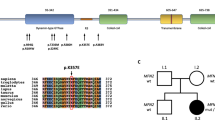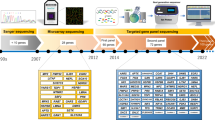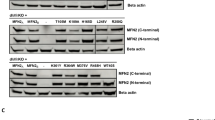Abstract
Immunoglobulin helicase μ-binding protein 2 (IGHMBP2) gene is responsible for Charcot–Marie–Tooth disease (CMT) type 2S and spinal muscular atrophy with respiratory distress type 1 (SMARD1). From June 2014 to December 2015, we collected 408 cases, who referred to our genetic laboratory for genetic analysis, suspected with CMT disease or other inherited peripheral neuropathies (IPNs) on the basis of clinical manifestations and electrophysiological studies. Mutation screening was performed using Ion AmpliSeq Custom Panels, which comprise 72 disease-causing or candidate genes of IPNs. We identified novel homozygous or compound heterozygous variants of IGHMBP2 in four patients. Three patients presented with childhood-onset axonal predominant sensorimotor polyneuropathies, whereas the other case was diagnosed with SMARD1, manifesting as low birth weight, weak cry, reduced spontaneous movement and developed respiratory distress 4 months after birth. We present the original report of CMT type 2S in Japan, and illustrate that recessive IGHMBP2 variants account for ~1.6% of axonal CMT in our cohort.
Similar content being viewed by others
Log in or create a free account to read this content
Gain free access to this article, as well as selected content from this journal and more on nature.com
or
References
Antonellis, A., Ellsworth, R. E., Sambuughin, N., Puls, I., Abel, A., Lee-Lin, S. Q. et al. Glycyl tRNA synthetase mutations in Charcot–Marie–Tooth disease type 2D and distal spinal muscular atrophy type V. Am. J. Hum. Genet. 72, 1293–1299 (2003).
Latour, P., Thauvin-Robinet, C., Baudelet-Mery, C., Soichot, P., Cusin, V., Faivre, L. et al. A major determinant for binding and aminoacylation of tRNA(Ala) in cytoplasmic alanyl-tRNA synthetase is mutated in dominant axonal Charcot–Marie–Tooth disease. Am. J. Hum. Genet. 86, 77–82 (2010).
Zhao, Z., Hashiguchi, A., Hu, J., Sakiyama, Y., Okamoto, Y., Tokunaga, S. et al. Alanyl-tRNA synthetase mutation in a family with dominant distal hereditary motor neuropathy. Neurology 78, 1644–1649 (2012).
Evgrafov, O. V., Mersiyanova, I., Irobi, J., Van Den Bosch, L., Dierick, I., Leung, C. L. et al. Mutant small heat-shock protein 27 causes axonal Charcot–Marie–Tooth disease and distal hereditary motor neuropathy. Nat. Genet. 36, 602–606 (2004).
Irobi, J., Van Impe, K., Seeman, P., Jordanova, A., Dierick, I., Verpoorten, N. et al. Hot-spot residue in small heat-shock protein 22 causes distal motor neuropathy. Nat. Genet. 36, 597–601 (2004).
Tang, B. S., Luo, W., Xia, K., Xiao, J. F., Jiang, H., Shen, L. et al. A new locus for autosomal dominant Charcot–Marie–Tooth disease type 2 (CMT2L) maps to chromosome 12q24. Hum. Genet. 114, 527–533 (2004).
Windpassinger, C., Auer-Grumbach, M., Irobi, J., Patel, H., Petek, E., Horl, G. et al. Heterozygous missense mutations in BSCL2 are associated with distal hereditary motor neuropathy and Silver syndrome. Nat. Genet. 36, 271–276 (2004).
Choi, B. O., Park, M. H., Chung, K. W., Woo, H. M., Koo, H., Chung, H. K. et al. Clinical and histopathological study of Charcot–Marie–Tooth neuropathy with a novel S90W mutation in BSCL2. Neurogenetics 14, 35–42 (2013).
Blumen, S. C., Astord, S., Robin, V., Vignaud, L., Toumi, N., Cieslik, A. et al. A rare recessive distal hereditary motor neuropathy with HSJ1 chaperone mutation. Ann. Neurol. 71, 509–519 (2012).
Gess, B., Auer-Grumbach, M., Schirmacher, A., Strom, T., Zitzelsberger, M., Rudnik-Schoneborn, S. et al. HSJ1-related hereditary neuropathies: novel mutations and extended clinical spectrum. Neurology 83, 1726–1732 (2014).
Auer-Grumbach, M., Olschewski, A., Papic, L., Kremer, H., McEntagart, M. E., Uhrig, S. et al. Alterations in the ankyrin domain of TRPV4 cause congenital distal SMA, scapuloperoneal SMA and HMSN2C. Nat. Genet. 42, 160–164 (2010).
Weedon, M. N., Hastings, R., Caswell, R., Xie, W., Paszkiewicz, K., Antoniadi, T. et al. Exome sequencing identifies a DYNC1H1 mutation in a large pedigree with dominant axonal Charcot–Marie–Tooth disease. Am. J. Hum. Genet. 89, 308–312 (2011).
Harms, M. B., Ori-McKenney, K. M., Scoto, M., Tuck, E. P., Bell, S., Ma, D. et al. Mutations in the tail domain of DYNC1H1 cause dominant spinal muscular atrophy. Neurology 78, 1714–1720 (2012).
Maystadt, I., Rezsohazy, R., Barkats, M., Duque, S., Vannuffel, P., Remacle, S. et al. The nuclear factor kappaB-activator gene PLEKHG5 is mutated in a form of autosomal recessive lower motor neuron disease with childhood onset. Am. J. Hum. Genet. 81, 67–76 (2007).
Azzedine, H., Zavadakova, P., Plante-Bordeneuve, V., Vaz Pato, M., Pinto, N., Bartesaghi, L. et al. PLEKHG5 deficiency leads to an intermediate form of autosomal-recessive Charcot–Marie–Tooth disease. Hum. Mol. Genet 22, 4224–4232 (2013).
Grohmann, K., Schuelke, M., Diers, A., Hoffmann, K., Lucke, B., Adams, C. et al. Mutations in the gene encoding immunoglobulin mu-binding protein 2 cause spinal muscular atrophy with respiratory distress type 1. Nat. Genet. 29, 75–77 (2001).
Cottenie, E., Kochanski, A., Jordanova, A., Bansagi, B., Zimon, M., Horga, A. et al. Truncating and missense mutations in IGHMBP2 cause Charcot–Marie–Tooth disease type 2. Am. J. Hum. Genet. 95, 590–601 (2014).
Guenther, U. P., Varon, R., Schlicke, M., Dutrannoy, V., Volk, A., Hubner, C. et al. Clinical and mutational profile in spinal muscular atrophy with respiratory distress (SMARD): defining novel phenotypes through hierarchical cluster analysis. Hum. Mutat. 28, 808–815 (2007).
Schottmann, G., Jungbluth, H., Schara, U., Knierim, E., Morales Gonzalez, S., Gill, E. et al. Recessive truncating IGHMBP2 mutations presenting as axonal sensorimotor neuropathy. Neurology 84, 523–531 (2015).
Richards, S., Aziz, N., Bale, S., Bick, D., Das, S., Gastier-Foster, J. et al. Standards and guidelines for the interpretation of sequence variants: a joint consensus recommendation of the American College of Medical Genetics and Genomics and the Association for Molecular Pathology. Genet. Med. 17, 405–424 (2015).
Shi, C. H., Song, B., Luo, H. Y., Mao, C. Y., Shang, D. D., Cao, Y. et al. Recessive hereditary motor and sensory neuropathy caused by IGHMBP2 gene mutation. Neurology 85, 383–384 (2015).
Luan, X., Huang, X., Liu, X., Zhou, H., Chen, S. & Cao, L. Infantile spinal muscular atrophy with respiratory distress type I presenting without respiratory involvement: Novel mutations and review of the literature. Brain Dev. 38, 685–689 (2016).
Schultz, J., Milpetz, F., Bork, P. & Ponting, C. P. SMART, a simple modular architecture research tool: identification of signaling domains. Proc. Natl Acad. Sci. USA 95, 5857–5864 (1998).
Maystadt, I., Zarhrate, M., Landrieu, P., Boespflug-Tanguy, O., Sukno, S., Collignon, P. et al. Allelic heterogeneity of SMARD1 at the IGHMBP2 locus. Hum. Mutat. 23, 525–526 (2004).
Molnar, G. M., Crozat, A., Kraeft, S. K., Dou, Q. P., Chen, L. B. & Pardee, A. B. Association of the mammalian helicase MAH with the pre-mRNA splicing complex. Proc. Natl Acad. Sci. USA 94, 7831–7836 (1997).
Moreira, M. C., Klur, S., Watanabe, M., Nemeth, A. H., Le Ber, I., Moniz, J. C. et al. Senataxin, the ortholog of a yeast RNA helicase, is mutant in ataxia-ocular apraxia 2. Nat. Genet. 36, 225–227 (2004).
Chen, Y. Z., Bennett, C. L., Huynh, H. M., Blair, I. P., Puls, I., Irobi, J. et al. DNA/RNA helicase gene mutations in a form of juvenile amyotrophic lateral sclerosis (ALS4). Am. J. Hum. Genet. 74, 1128–1135 (2004).
Wagner, J. D., Huang, L., Tetreault, M., Majewski, J., Boycott, K. M., Bulman, D. E. et al. Autosomal recessive axonal polyneuropathy in a sibling pair due to a novel homozygous mutation in IGHMBP2. Neuromuscul. Disord. 25, 794–799 (2015).
Pedurupillay, C. R., Amundsen, S. S., Baroy, T., Rasmussen, M., Blomhoff, A., Stadheim, B. F. et al. Clinical and molecular characteristics in three families with biallelic mutations in IGHMBP2. Neuromuscul. Disord. 26, 570–575 (2016).
Appleton, R. E., Hubner, C., Grohmann, K. & Varon, R. 'Congenital peripheral neuropathy presenting as apnoea and respiratory insufficiency: spinal muscular atrophy with respiratory distress type 1 (SMARD1)'. Dev. Med. Child. Neurol. 46, 576 (2004).
Pierson, T. M., Tart, G., Adams, D., Toro, C., Golas, G., Tifft, C. et al. Infantile-onset spinal muscular atrophy with respiratory distress-1 diagnosed in a 20-year-old man. Neuromuscul. Disord. 21, 353–355 (2011).
Grohmann, K., Varon, R., Stolz, P., Schuelke, M., Janetzki, C., Bertini, E. et al. Infantile spinal muscular atrophy with respiratory distress type 1 (SMARD1). Ann. Neurol. 54, 719–724 (2003).
Rudnik-Schoneborn, S., Stolz, P., Varon, R., Grohmann, K., Schachtele, M., Ketelsen, U. P. et al. Long-term observations of patients with infantile spinal muscular atrophy with respiratory distress type 1 (SMARD1). Neuropediatrics 35, 174–182 (2004).
Jedrzejowska, M., Madej-Pilarczyk, A., Fidzianska, A., Mierzewska, H., Pronicka, E., Obersztyn, E. et al. Severe phenotypes of SMARD1 associated with novel mutations of the IGHMBP2 gene and nuclear degeneration of muscle and Schwann cells. Eur. J. Paediatr. Neurol. 18, 183–192 (2014).
Butterfield, R. J., Stevenson, T. J., Xing, L., Newcomb, T. M., Nelson, B., Zeng, W. et al. Congenital lethal motor neuron disease with a novel defect in ribosome biogenesis. Neurology 82, 1322–1330 (2014).
Guenther, U. P., Schuelke, M., Bertini, E., D'Amico, A., Goemans, N., Grohmann, K. et al. Genomic rearrangements at the IGHMBP2 gene locus in two patients with SMARD1. Hum. Genet. 115, 319–326 (2004).
Stalpers, X. L., Verrips, A., Poll-The, B. T., Cobben, J. M., Snoeck, I. N., de Coo, I. F. et al. Clinical and mutational characteristics of spinal muscular atrophy with respiratory distress type 1 in The Netherlands. Neuromuscul. Disord. 23, 461–468 (2013).
Acknowledgements
We thank the patients and their family members for participation in the study. We thank Aya Ebina and Tomoko Onishi of our department for her excellent technical assistance, and Enago (http://www.enago.jp) for the English language review. This study was supported, in part, by grants from research on the Nervous and Mental Disorders and Research Committee for Charcot–Marie–Tooth Disease, Neuropathy, Ataxic Disease and Applying Health and Technology of Ministry of Health, Welfare and Labour, Japan. This research is also supported by the research program for conquering intractable disease from Japan Agency for Medical Research and Development (AMED).
Author information
Authors and Affiliations
Corresponding author
Ethics declarations
Competing interests
The authors declare no conflict of interest.
Rights and permissions
About this article
Cite this article
Yuan, JH., Hashiguchi, A., Yoshimura, A. et al. Clinical diversity caused by novel IGHMBP2 variants. J Hum Genet 62, 599–604 (2017). https://doi.org/10.1038/jhg.2017.15
Received:
Revised:
Accepted:
Published:
Issue date:
DOI: https://doi.org/10.1038/jhg.2017.15
This article is cited by
-
Clinical genetics of Charcot–Marie–Tooth disease
Journal of Human Genetics (2023)



